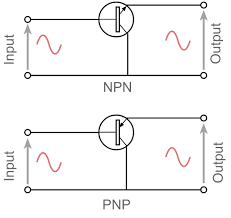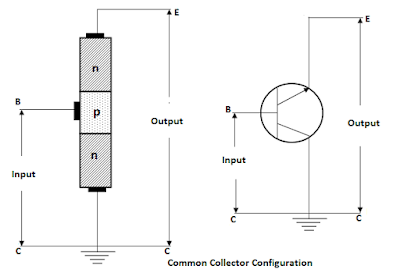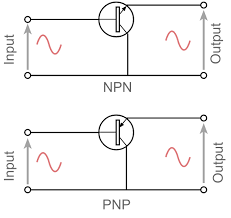
Three transistor configurations
-
The input is applied between the common port and one of the other two ports. The output is taken between the common terminal and the remaining terminal.
-
The term “common” refers to the area common to the input and output circuits.
-
As a result, a transistor can be connected in the following three different configurations.
Transistor circuit configuration
The following figure shows the Transistor circuit design with npn transistors:
-
Common Compound – Base (CB)
-
Common Emitter Terminal (CE)
-
Common Collector (CC) Connection
Common Compound – Base (CB)
The common base (CB) connection is a basic configuration used in bipolar transistors (BJTs) in electronics. The base connection is connected to the common connection, usually the negative or ground pole. The emitter terminal is connected to the input signal while the collector terminal is connected to the output load. The CB connection is also called a grounded base configuration and has special properties and applications. It provides current gain where a small change in input current results in a larger change in output current. However, the voltage gain is less than unity, which means the output voltage is less than the input voltage.

The CB configuration is used in impedance matching, frequency multiplication, and high-frequency amplification, although it is less commonly used than other configurations such as common emitter (CE) and common collector (CC). By understanding the CB junction and its unique characteristics, engineers can select the appropriate transistor configuration to meet the needs of their specific circuits or systems.
Common Emitter Terminal (CE)
The common emitter (CE) connection is one of the primary configurations used in bipolar transistors (BJTs) and is of great importance in electronics. In this configuration, the emitter terminal is connected to the common or ground terminal, while the base terminal serves as the input and the collector terminal serves as the output. The CE connection offers several advantages and is, therefore, the most used configuration. It provides voltage and current gain, so small changes in input current can result in larger changes in output current.
This configuration also provides voltage gain where the output voltage can be significantly greater than the input voltage. The CE connector has a relatively high input impedance and low output impedance, making it suitable for a variety of applications, including audio amplifiers, voltage amplifiers, and signal processing circuits. Its versatility and robust performance have established the CE connector as a fundamental element in modern electronics.

Common Collector (CC) Connection
Common collector (CC) connection, also known as emitter-follower configuration or voltage-follower configuration, is a basic circuit configuration used in bipolar transistors (BJTs) in electronics. In this configuration, the collector terminal is connected to the common or ground terminal, while the emitter terminal serves as the output and the base terminal serves as the input. CC compound offers unique properties and is widely used in various applications.
An important advantage of the DC configuration is that it offers high input impedance, making it ideal for impedance matching between different stages of a circuit. Furthermore, it offers low output impedance, allowing you to effectively drive low impedance loads.
The DC connection has a voltage gain slightly less than unity, which means the output voltage closely follows the input voltage, resulting in voltage buffering rather than gain. This feature is useful in applications where the main objective is to maintain signal integrity and provide isolation between the input and output stages.

Additionally, the DC configuration provides excellent current gain, ensuring that the output current follows the input current with minimal distortion. This property is suitable for impedance bridging, buffering and signal isolation applications.
Additionally, the DC configuration has a phase shift of approximately 180 degrees between the input and output signals, which can be beneficial in certain circuits where phase relationships are critical.
Due to its impedance matching capability, low output impedance and voltage buffering, the DC connection is widely used in audio amplifiers, buffer stages and as an interface between various parts of the circuit. Due to its versatile properties and wide range of applications, the DC connection is indispensable in modern electronic design.
Principle and working of transistor
Polarized transistor
-
Active forwarding mode
-
Saturation mode
-
Shutdown mode
Active forwarding mode
Saturation Mode
Shutdown mode
In this mode, both the emitter-base junctions and the collector-base junctions are reverse biased. In this case, the current in the transistor is practically zero. The transistor operates in this mode when it is intended to be used as an open switch; For the switching application of a transistor, saturation and turn-off methods are used interchangeably.
Comparison of transistor configurations
| Common issuer | common collector | Common ground | |
|
Voltage gain
|
Average
|
Low
|
High
|
|
Current reinforcement
|
Average
|
High
|
Low
|
|
Input Impedance
|
Average
|
High
|
Low
|
|
Output Impedance
|
Average
|
Low
|
High
|
Conclusion
In this article, we look at the basic transistor circuit configurations such as emitter circuit, base circuit, and collector circuit, each with unique properties and applications. We saw how these configurations enable signal amplification, switching, and processing, laying the foundation for the advanced electronics we rely on today.

